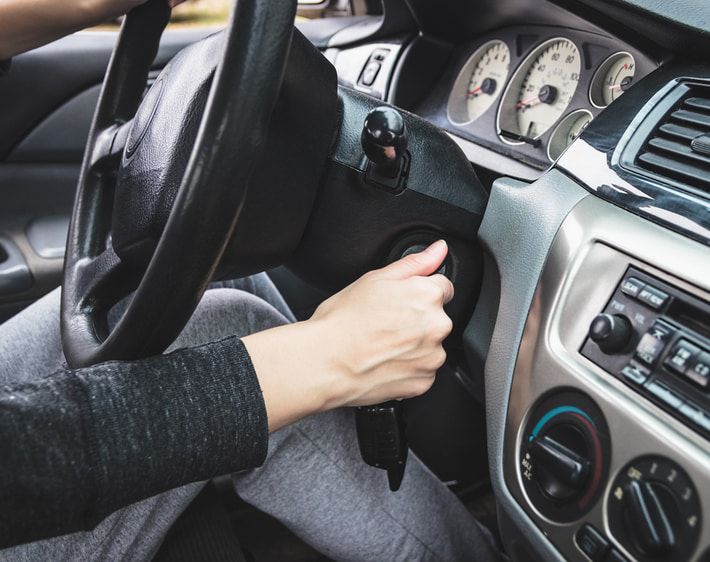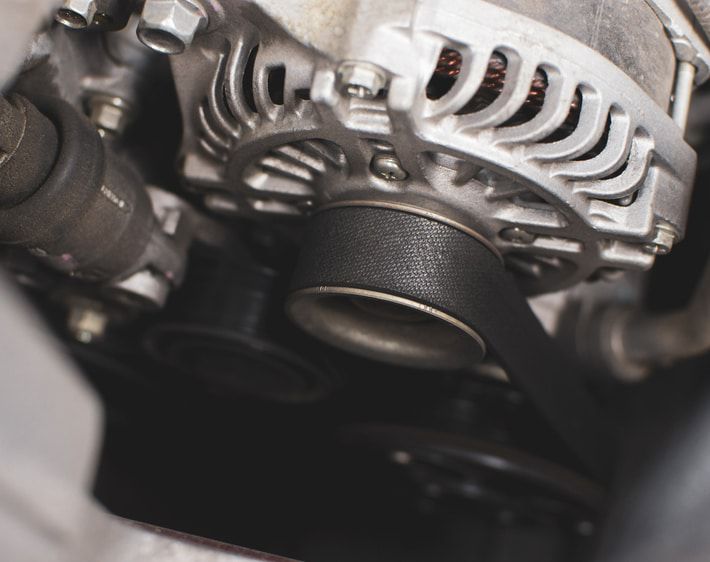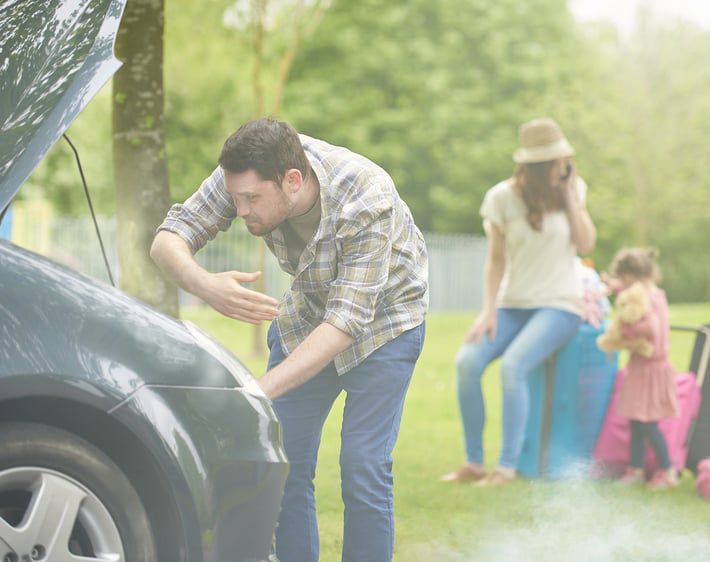Are you wondering why your car won’t start? Issues with the starter system are more common than you think, but drivers often confuse them with other car troubles. Read up on bad starter symptoms and learn how to tell them apart from other problems.
What Is A Starter?
The starter is a small motor, powered by the battery. It gets the engine of your car running. A starter relay sits between the battery and the starter motor, transmitting power. Without a properly working starter relay and motor, you won’t be able to start your vehicle and may need a tow.
What Are Common Bad Starter Symptoms?
1. Something sounds off.
One of the symptoms of a bad starter is a clicking noise when you turn the key or push the start button. However, a starter can die without making any sound at all, or it may announce its impending death with whirring and grinding noise—so listen up!
2. You’ve got lights but no action.
If you try to start the engine only to find that the dashboard lights up, but the engine doesn’t power up, you might have a problem with the starter.
3. Your engine won't crank.
Is your engine not revving up, even after attempting a jumpstart? At this point, it’s time to call roadside assistance and get your car to the nearest Firestone Complete Auto Care. If a jumpstart won’t fire up your engine, nothing other than a certified technician will!
4. Smoke is coming from your car.
The starter is part of your car’s electrical system and subject to blown fuses and short circuits. When you’ve been desperately attempting to start your car, the starter can overheat making electrical issues—and the accompanying smoke—more likely. If you see or smell smoke, call for help rather than turning the key harder, again!
5. Oil has soaked the starter.
Your starter can usually be found on the passenger's side (if RWD) of the engine, just below the exhaust manifold. Or if it is FWD, check on the drivers side above the transmission or under the exhaust manifold. They can also be located just under the intake manifold on some vehicles. If you pop the hood only to find that your starter is drenched in engine oil, your bad starter might be a symptom of another problem—an oil leak. Unfortunately, what starts out as a few drops of oil can slowly and sometimes unnoticeably turn into an expensive problem, so keep an eye out for oil leaks to avoid starter issues of this nature.
What Causes Starter Problems?
A variety of problems can lead to a bad starter, including:
- Loose wiring to and from the starter – Loose wiring can disrupt the starter’s connection to electrical power, so your engine may not crank.
- Dirty or corroded connections at the starter – Built-up dirt or corrosion causes higher resistance between circuits and disrupts the flow of power. This can cause a very weak crank or failure to crank.
- Battery corrosion – Whether it’s due to overheating, damage from leaking, or battery age, a corroded battery can cause electrical problems if left unattended.
- Damaged or worn-out parts in the starter system – Over time, parts that conduct and distribute electrical power in the starter system (like the starter to battery cable and the starter relay) may wear out and need replacement. If you have parts in your starter system that fail, a technician can help repair and replace faulty parts.
- Oil leaks – Typically a problem with older vehicles, oil can leak out of an engine after years of wear and tear. If enough engine oil leaks onto the starter, it may become inoperable—and you’ll need engine oil leak repair plus a replacement starter.
- Bad relay – A bad starter relay can leave you with either an engine that won’t turn over or a starter that continues to crank after start-up.
How Do You Diagnose And Troubleshoot Starter Problems?
Assuming you’ve already tried to start and jumpstart your car, try one of the following troubleshooting tips.
1. Look under the hood.
Check the battery and battery cables to see whether everything’s in working order. A weak or dead battery, or even faulty battery cables, could be causing the problems with your car, not the starter.
2. Tap the starter.
Try lightly tapping the starter a few times with a hard object, making sure not to pound it. In some cases, this gentle tapping can help power it back up, since you’ll be tapping the electrical components back in contact with each other. Know how you can sometimes bang on the side of an old TV to bring the picture back into focus? It's kind of like that. But like your wonky television, your car may only react to this fix temporarily—just long enough to get you to your nearest service center.
3. Adjust the transmission.
Let’s say your car’s automatic transmission is in the “park” setting but the car won’t start. If that’s the case, try starting the car in “neutral.” If it starts in "neutral," there may be a technical glitch that’s preventing the car from starting in "park," like a faulty neutral safety switch.
4. Check the fuel gauge.
We know it seems silly but...is your gas tank empty? That’s a sure reason why your car isn’t starting!
Many times, the quick fix for a bad starter is tapping it. Jumpstarting your car can get it on the road, at least temporarily, but then you'll want to get the problem checked out by a qualified technician. If a jumpstart or tap doesn’t do the trick, you’ll most likely need to get the car towed and have the starter repaired or replaced. We can help with that.
When you suspect a starter problem, start with your local Firestone Complete Auto Care. We'll provide you with a free inspection—no strings attached. If your starter is bad, our experienced technicians can get your car fixed right, at the right price, right on time.
How To Start A Car With A Bad Starter
Starting a car with a bad starter can be challenging, but there are a few steps you can try as a temporary solution. Here's how to get a car going when the car starter is not working:
1. First, Safely Park Your Car.
Make sure your car is off the road and away from traffic flow. Put your vehicle in park or neutral if it’s a manual transmission, and then engage the parking brake for your safety.
2. Find The Starter Motor.
Pop the hood of your vehicle and look for the starter motor. It will typically look like a large metal cylinder with a smaller cylinder stacked on top. The location of the starter motor may be different depending on the make and model of your vehicle. Be careful, as some parts of the exhaust could be extremely hot, AND the electrical terminals on the starter may be attached directly to the battery and will short/spark!
3. Start With The Try The Tapping Method.
Helping a starter motor come to life is one of the few times some percussive maintenance is useful. Once you’ve found the starter motor, try tapping it gently with a hammer or a similar object. By tapping on the starter, you’re aiming to help unstick starter brushes so they can engage and start up the system. If your vehicle starts after using the tapping method, you should make your way to your nearest Firestone Complete Auto Care for a more comprehensive starter repair. Be careful to not tap too hard! There may be brittle magnets inside the starter housing.
4. If Tapping Fails, Prepare To Jump-start Your Car.
If tapping doesn't work, another option is to jump-start your car. So, call over a friend with a working vehicle battery and grab a pair of jumper cables.
Go through the standard procedure for jumping a car battery. Always refer to your owner's manual for your vehicle’s specific instructions. To connect the batteries using jumper cables, inspect the positive and negative terminals on the batteries in each vehicle and make sure they are free of corrosion and not loose. Jumper cables are color coded, typically red for positive and black for negative.
Connect a positive clamp first to the positive terminal of the dead battery and then the other end of the positive cable to the positive terminal of the live battery. Then connect the negative clamp to the negative terminal of the dead battery and the other end of the negative cable to the negative terminal of the live battery.
5. Use A Working Car To Charge The Battery.
Now it’s time to jump the battery. Have someone start the working vehicle and let it run for a few minutes to charge the inactive car's dead battery.
6. Attempt To Start Your Car.
After taking time to charge the battery, you can attempt to start your car. While the jumper cables are still connected, turn the ignition of your vehicle. With the extra power coming from the live battery, you should have enough energy to start the engine and bypass the dead battery.
7. Disconnect Your Vehicle And Drive To Your Nearest Repair Shop.
Once the car has started, keep it running and carefully disconnect it from the working vehicle. Start by removing the negative clamp attached to the negative terminal on the helper vehicle, and then remove the negative clamp on the negative terminal from the jump-started vehicle. Next, remove the positive clamp on one end of the positive cable from your helper’s vehicle. Finally, remove the last positive clamp on your vehicle’s positive battery terminal. Avoid turning off the jumped car’s engine until you reach your destination or a repair shop.
Remember, starting a car with a bad starter is only a temporary solution. So, when you encounter a starter problem, start with your local Firestone Complete Auto Care. If your starter is bad, our experienced technicians can get your car fixed right, at the right price, right on time.


